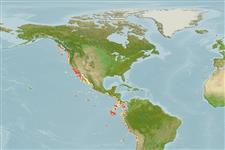Environment: milieu / climate zone / depth range / distribution range
Ekologi
marina batypelagisk; djupintervall 225 - 1400 m (Ref. 96339). Deep-water; 55°N - 23°S, 135°W - 70°W
Eastern Pacific: off British Columbia, Canada (Ref. 12204), and from Washington, USA (48°N) to Chile (23°S) (Ref. 35760).
Size / Vikt / Age
Maturity: Lm ? range ? - ? cm
Max length : 25.0 cm SL hane/ej könsbestämd; (Ref. 96339)
Short description
Morfologi | Morfometri
Taggstrålar i ryggfenan (totalt): 0; Mjukstrålar i ryggfenan (totalt): 17-20; Taggstrålar i analfenan 0; Mjukstrålar i analfenan: 14 - 16; Ryggkotor: 46 - 50. Dark in color with 2 white tissue patches behind the eye (Ref. 12204). Light organ at tip of lower jaw and long gill filaments not united at their bases (Ref. 12204). Branchiostegal rays: 8-9.
Usually near coasts (Ref. 12204). Oviparous, with large mesopelagic larvae (Ref. 35760).
Life cycle and mating behavior
Könsmognad | Reproduktion | Lek | Ägg | Fecundity | Larver
Coad, B.W., 1995. Encyclopedia of Canadian fishes. Canadian Museum of Nature and Canadian Sportfishing Productions Inc. Singapore. (Ref. 12204)
IUCN Red List Status (Ref. 130435)
Threat to humans
Harmless
Human uses
Ytterligare information
Age/SizeTillväxtLength-weightLength-lengthLength-frequenciesMorfometriMorfologiLarverLarvdynamikRekryteringAbundansBRUVS
referenserVattenbrukVattenbruksprofilAvelslinjerGenetikElectrophoresesÄrftlighetSjukdomarBehandlingNutrientsMass conversion
MedarbetareBilderStamps, Coins Misc.LjudCiguateraHastighetSimsättGälytaOtolithsHjärnstorlekSyn
Verktyg
Special reports
Download XML
Internet-källor
Estimates based on models
Preferred temperature (Ref.
123201): 3.8 - 5, mean 4.7 °C (based on 19 cells).
Phylogenetic diversity index (Ref.
82804): PD
50 = 0.5020 [Uniqueness, from 0.5 = low to 2.0 = high].
Bayesian length-weight: a=0.00407 (0.00154 - 0.01080), b=3.17 (2.95 - 3.39), in cm total length, based on LWR estimates for this (Sub)family-body shape (Ref.
93245).
Trofisk nivå (Ref.
69278): 3.4 ±0.5 se; based on size and trophs of closest relatives
Resiliens (Ref.
120179): Mellan, lägsta populationsfördubblingstid 1,4-4,4 år (Assuming tmax>3).
Fishing Vulnerability (Ref.
59153): Low vulnerability (21 of 100).
